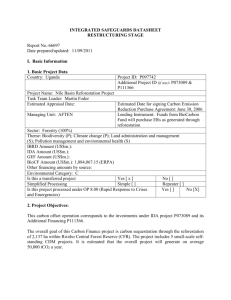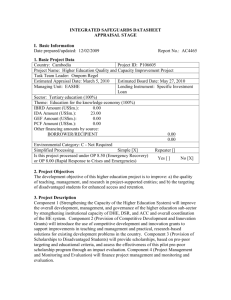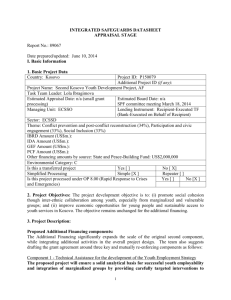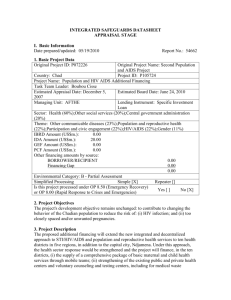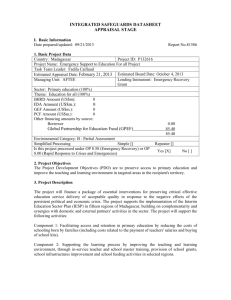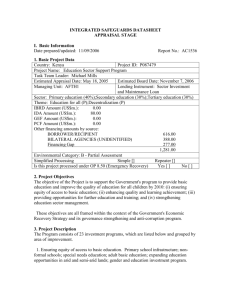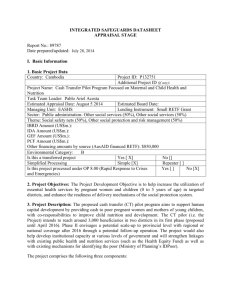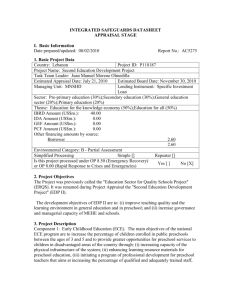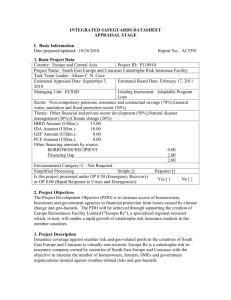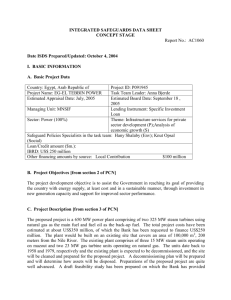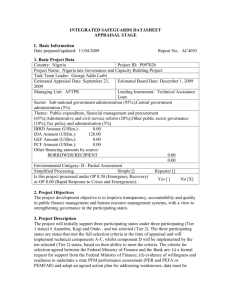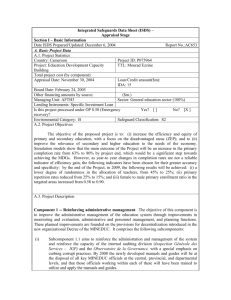integrated safeguards datasheet - Documents & Reports
advertisement
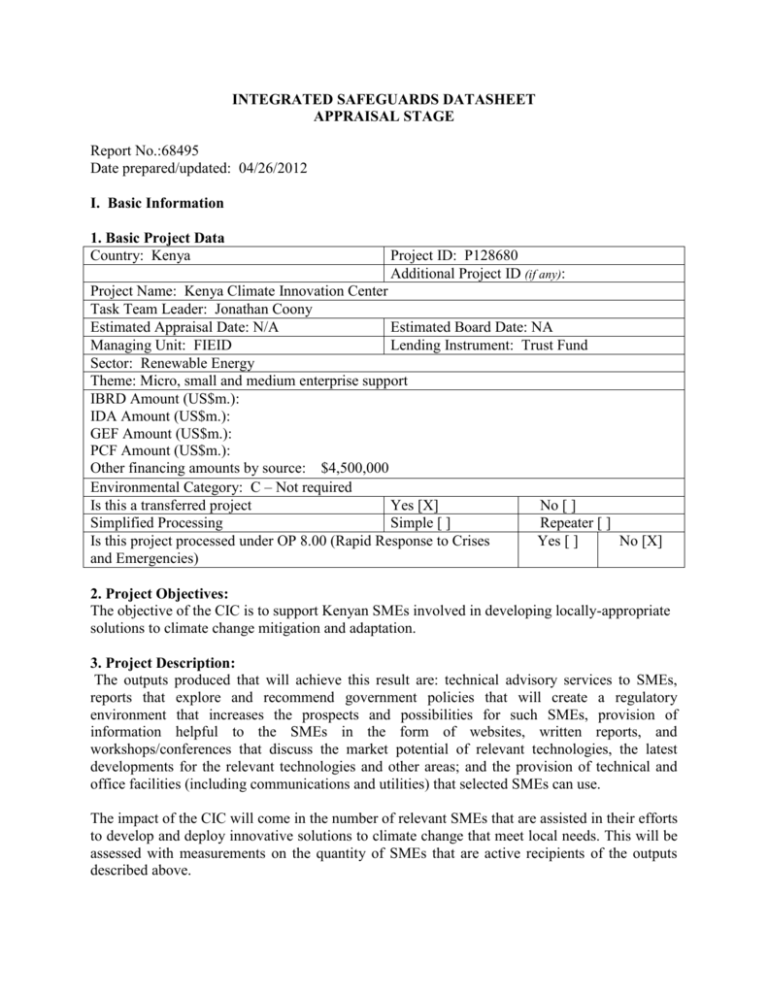
INTEGRATED SAFEGUARDS DATASHEET APPRAISAL STAGE Report No.:68495 Date prepared/updated: 04/26/2012 I. Basic Information 1. Basic Project Data Country: Kenya Project ID: P128680 Additional Project ID (if any): Project Name: Kenya Climate Innovation Center Task Team Leader: Jonathan Coony Estimated Appraisal Date: N/A Estimated Board Date: NA Managing Unit: FIEID Lending Instrument: Trust Fund Sector: Renewable Energy Theme: Micro, small and medium enterprise support IBRD Amount (US$m.): IDA Amount (US$m.): GEF Amount (US$m.): PCF Amount (US$m.): Other financing amounts by source: $4,500,000 Environmental Category: C – Not required Is this a transferred project Yes [X] No [ ] Simplified Processing Simple [ ] Repeater [ ] Is this project processed under OP 8.00 (Rapid Response to Crises Yes [ ] No [X] and Emergencies) 2. Project Objectives: The objective of the CIC is to support Kenyan SMEs involved in developing locally-appropriate solutions to climate change mitigation and adaptation. 3. Project Description: The outputs produced that will achieve this result are: technical advisory services to SMEs, reports that explore and recommend government policies that will create a regulatory environment that increases the prospects and possibilities for such SMEs, provision of information helpful to the SMEs in the form of websites, written reports, and workshops/conferences that discuss the market potential of relevant technologies, the latest developments for the relevant technologies and other areas; and the provision of technical and office facilities (including communications and utilities) that selected SMEs can use. The impact of the CIC will come in the number of relevant SMEs that are assisted in their efforts to develop and deploy innovative solutions to climate change that meet local needs. This will be assessed with measurements on the quantity of SMEs that are active recipients of the outputs described above. There will be substantial knowledge generated by the activities of the CIC. This knowledge will relate to best practices to support the development, transfer and deployment of advanced climate technologies and business models in a way that directly supports local capacity to do so, targeting the essential SME community in its key role in the innovation process and ecosystem. This knowledge will be disseminated directly through the CIC in written reports, local conferences and a website, and also internationally (via the same methods) through the planned East African regional community of CICs and related actors and globally through the network of CICs. 4. Project Location and salient physical characteristics relevant to the safeguard analysis: The CIC will be housed in the Strathmore Business School Building in Nairobi – a 8,000 square meter green building in Madaraka, 4 kms from the City Centre and 1 km from Industrial Area. 5. Environmental and Social Safeguards Specialists on the Team: 6. Safeguard Policies Triggered (please explain why) Environmental Assessment (OP/BP 4.01) Natural Habitats (OP/BP 4.04) Forests (OP/BP 4.36) Pest Management (OP 4.09) Physical Cultural Resources (OP/BP 4.11) Indigenous Peoples (OP/BP 4.10) Involuntary Resettlement (OP/BP 4.12) Safety of Dams (OP/BP 4.37) Projects on International Waterways (OP/BP 7.50) Projects in Disputed Areas (OP/BP 7.60) Yes No X X X X X X X X X X II. Key Safeguard Policy Issues and Their Management A. Summary of Key Safeguard Issues 1. Describe any safeguard issues and impacts associated with the proposed project. Identify and describe any potential large scale, significant and/or irreversible impacts: Kenya Climate Innovation Center will have major positive environmental impacts as it will support innovators develop and disseminate clean technologies for the domestic industry resulting in a cleaner environment. The project will have a direct positive social impact as it aims to improve quality of lives by supporting job creation. Additionally it is designed to promote economic development countrywide including rural areas which has a significant population of poor people engaged in agri-business. The project will not involve construction or rehabilitation of facilities. The CIC will be housed in a brand new LEED certified building which is already built, and office partitions will be set up on some of the floors of the building to separate out the workspace. Anticipated negative impacts of the project include temporary disturbances in noise and air quality and public health and safety issues during the implementation of climate technology solutions. These impacts are expected to be very limited and appropriate screening will be managed through the Environmental Impact Assessment checklist as and when required developed by the Client. Where required, permits for proposed project activities (e.g. setting up office partitions) will be obtained according to Kenya NEMA rules. 2. Describe any potential indirect and/or long term impacts due to anticipated future activities in the project area: N/A 3. Describe any project alternatives (if relevant) considered to help avoid or minimize adverse impacts: N/A 4. Describe measures taken by the borrower to address safeguard policy issues. Provide an assessment of borrower capacity to plan and implement the measures described: N/A 5. Identify the key stakeholders and describe the mechanisms for consultation and disclosure on safeguard policies, with an emphasis on potentially affected people: In addition to PwC Kenya, GVEP International, Strathmore University, and Kenya Industrial Research and Development Institute, the project stakeholders will include Small and Medium Enterprises in Kenya and other Kenyan businesses, entrepreneurs and innovators working with CIC. B. Disclosure Requirements Date Environmental Assessment/Audit/Management Plan/Other: Was the document disclosed prior to appraisal? Date of receipt by the Bank Date of "in-country" disclosure Date of submission to InfoShop For category A projects, date of distributing the Executive Summary of the EA to the Executive Directors Resettlement Action Plan/Framework/Policy Process: Was the document disclosed prior to appraisal? Date of receipt by the Bank Date of "in-country" disclosure Date of submission to InfoShop Indigenous Peoples Plan/Planning Framework: Was the document disclosed prior to appraisal? Date of receipt by the Bank Date of "in-country" disclosure N/A N/A N/A N/A N/A N/A N/A N/A N/A N/A N/A N/A Date of submission to InfoShop N/A Pest Management Plan: Was the document disclosed prior to appraisal? N/A Date of receipt by the Bank N/A Date of "in-country" disclosure N/A Date of submission to InfoShop N/A * If the project triggers the Pest Management and/or Physical Cultural Resources policies, the respective issues are to be addressed and disclosed as part of the Environmental Assessment/Audit/or EMP. If in-country disclosure of any of the above documents is not expected, please explain why: C. Compliance Monitoring Indicators at the Corporate Level (to be filled in when the ISDS is finalized by the project decision meeting) OP/BP 4.01 - Environment Assessment Does the project require a stand-alone EA (including EMP) report? If yes, then did the Regional Environment Unit or Sector Manager (SM) review and approve the EA report? Are the cost and the accountabilities for the EMP incorporated in the credit/loan? OP/BP 4.04 - Natural Habitats Would the project result in any significant conversion or degradation of critical natural habitats? If the project would result in significant conversion or degradation of other (non-critical) natural habitats, does the project include mitigation measures acceptable to the Bank? OP 4.09 - Pest Management Does the EA adequately address the pest management issues? Is a separate PMP required? If yes, has the PMP been reviewed and approved by a safeguards specialist or Sector Manager? Are PMP requirements included in project design? If yes, does the project team include a Pest Management Specialist? OP/BP 4.11 – Physical Cultural Resources Does the EA include adequate measures related to cultural property? Does the credit/loan incorporate mechanisms to mitigate the potential adverse impacts on physical cultural resources? OP/BP 4.10 - Indigenous Peoples Yes [ ] No [ ] N/A [ X ] Yes [ ] No [ ] N/A [ X ] Yes [ ] No [ ] N/A [ X ] Yes [ ] No [ ] N/A [ X ] Yes [ ] No [ ] N/A [ X ] Has a separate Indigenous Peoples Plan/Planning Framework (as appropriate) been prepared in consultation with affected Indigenous Peoples? If yes, then did the Regional unit responsible for safeguards or Sector Manager review the plan? If the whole project is designed to benefit IP, has the design been reviewed and approved by the Regional Social Development Unit? OP/BP 4.12 - Involuntary Resettlement Has a resettlement plan/abbreviated plan/policy framework/process framework (as appropriate) been prepared? If yes, then did the Regional unit responsible for safeguards or Sector Manager review and approve the plan/policy framework/process framework? OP/BP 4.36 – Forests Has the sector-wide analysis of policy and institutional issues and constraints been carried out? Does the project design include satisfactory measures to overcome these constraints? Does the project finance commercial harvesting, and if so, does it include provisions for certification system? OP/BP 4.37 - Safety of Dams Have dam safety plans been prepared? Have the TORs as well as composition for the independent Panel of Experts (POE) been reviewed and approved by the Bank? Has an Emergency Preparedness Plan (EPP) been prepared and arrangements been made for public awareness and training? OP/BP 7.50 - Projects on International Waterways Have the other riparians been notified of the project? If the project falls under one of the exceptions to the notification requirement, has this been cleared with the Legal Department, and the memo to the RVP prepared and sent? What are the reasons for the exception? Please explain: Has the RVP approved such an exception? OP/BP 7.60 - Projects in Disputed Areas Has the memo conveying all pertinent information on the international aspects of the project, including the procedures to be followed, and the recommendations for dealing with the issue, been prepared Does the PAD/MOP include the standard disclaimer referred to in the OP? Yes [ ] No [ ] N/A [ X ] Yes [ ] No [ ] N/A [ X ] Yes [ ] No [ ] N/A [ X ] Yes [ ] No [ ] N/A [ X ] Yes [ ] No [ ] N/A [ X ] Yes [ ] No [ ] N/A [ X ] The World Bank Policy on Disclosure of Information Have relevant safeguard policies documents been sent to the World Bank's Infoshop? Have relevant documents been disclosed in-country in a public place in a form and language that are understandable and accessible to project-affected groups and local NGOs? All Safeguard Policies Have satisfactory calendar, budget and clear institutional responsibilities been prepared for the implementation of measures related to safeguard policies? Have costs related to safeguard policy measures been included in the project cost? Does the Monitoring and Evaluation system of the project include the monitoring of safeguard impacts and measures related to safeguard policies? Have satisfactory implementation arrangements been agreed with the borrower and the same been adequately reflected in the project legal documents? Yes [ ] No [ ] N/A [ X ] Yes [ ] No [ ] N/A [ X ] D. Approvals Signed and submitted by: Task Team Leader: Environmental Specialist: Social Development Specialist Additional Environmental and/or Social Development Specialist(s): Name Jonathan Coony Date May 1, 2012 Approved by: Regional Safeguards Coordinator: Alexandra Bezeredi May 1, 2012 Comments: No safeguards specialist required if project remains as defined in PCN and ISDS. Later, should project involve land acquisition, construction, or potential environmental or social impacts, consult Africa Safeguards Unit. Sector Manager: Valerie D'Costa May 1, 2012 Comments: (Template Version November 2007)
